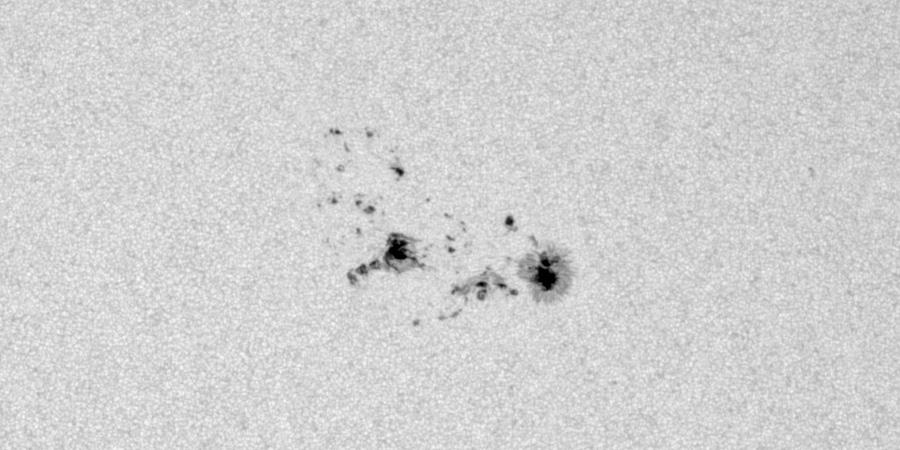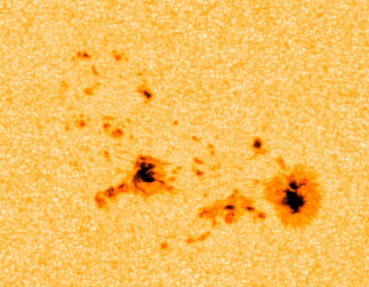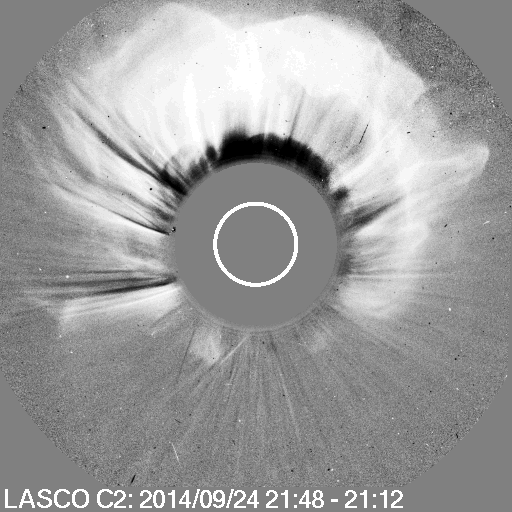New region 2175: a fast growing sunspot region
Thursday, 25 September 2014 15:39 UTC

A new sunspot region (NOAA number 2175) has emerged at 16 degrees north and 8 degrees west. It developed rapidly during the past 24 hours, both in size and complexity. Could this new sunspot region produce a strong solar flare?
The video above shows the development of sunspot region 2175 over just 24 hours as seen by NASA's Solar Dynamics Observatory in the 1600 Ångström wavelength. At the beginning of the video there is nothing there and at the end of the video there is a sunspot region which covers more area than surface of planet Earth. A thing to note is that there are also two filaments (not in the video) located near this sunspot region. If sunspot region 2175 continues to develop it might destabilize the filaments which in turn could cause and earth-directed eruption.
If we take a look at the magnetic layout of sunspot region 2175 we can already conclude that it developed a Beta-Gamma magnetic layout with some magnetic mixing both in the trailing as well as the leader spots. If we look closely we see that there is even a delta candidate near the large leader spot but there is no umbra to be seen yet. Strong solar flares are not very likely yet but if development continues the coming 24 hours the chances will most certainly rise.


Images and video: NASA SDO.
Sunspot region 2172
Sunspot region 2172 remains largly unchanged since our update yesterday but it did lose some magnetic complexity. There is a tiny bit of magnetic mixing but it is not really worth mentioning. A Beta-Gamma configuration remains but it could become a Beta region soon. M-class flares remain unlikely.
Farside solar flare
Old sunspot region 2158 (source of the 10 September X1 solar flare) remains active as it transits the far side of the Sun. It was the source of a strong solar flare last evening that produced a full halo coronal mass ejection as seen by SOHO/LASCO. As it was a far side event, the coronal mass ejection is of course heading away from Earth. Old sunspot region 2158 is now about 6 days away from rotating into view on the east-limb. Let's hope it stays active!

Image: far side full halo coronal mass ejection (CME) as seen by NASA/ESA SOHO.
Sunspot region 2175 is now Beta-Gamma-Delta (ADDED 20:00 UTC)
Things can go quickly on our nearest star and sunspot region 2175 is a great example. Just 4 hours ago we wrote it is a region with a Beta-Gamma magnetic layout but it continued to develop and surprisingly it now has a delta within it's trailing section. This is something which was not visible just 4 hours ago! There remains an area of positive polarity near the large leader spot but there is no umbra visible there so no delta there yet. There is an increased risk for an M-class solar flare with region 2175 being the most likely candidate as the region continues to grow and gain in magnetic complexity.

Thank you for reading this article! Did you have any trouble with the technical terms used in this article? Our help section is the place to be where you can find in-depth articles, a FAQ and a list with common abbreviations. Still puzzled? Just post on our forum where we will help you the best we can!
Latest news
Latest forum messages
Support SpaceWeatherLive.com!
A lot of people come to SpaceWeatherLive to follow the Sun's activity or if there is aurora to be seen, but with more traffic comes higher server costs. Consider a donation if you enjoy SpaceWeatherLive so we can keep the website online!

Space weather facts
| Last X-flare | 2024/12/08 | X2.2 |
| Last M-flare | 2024/12/23 | M1.0 |
| Last geomagnetic storm | 2024/12/17 | Kp5+ (G1) |
| Spotless days | |
|---|---|
| Last spotless day | 2022/06/08 |
| Monthly mean Sunspot Number | |
|---|---|
| November 2024 | 152.5 -13.9 |
| December 2024 | 106.6 -45.9 |
| Last 30 days | 116.1 -41.8 |


